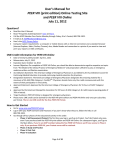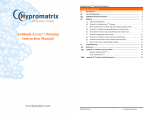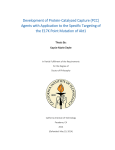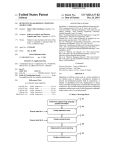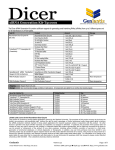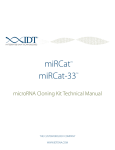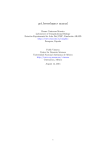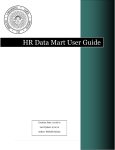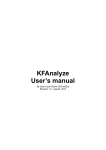Download Antibody Microarrays 380 & 500 User Manual
Transcript
User Manual Antibody Microarrays 380 & 500 User Manual United States/Canada 800.662.2566 Asia Pacific +1.650.919.7300 Europe +33.(0)1.3904.6880 Japan +81.(0)77.543.6116 Clontech Laboratories, Inc. A Takara Bio Company 1290 Terra Bella Ave. Mountain View, CA 94043 Technical Support (US) E-mail: [email protected] www.clontech.com Cat. Nos. 631790 631795 631786 631796 631797 631798 PT3648-1(PR123821) Published February 2011 Antibody Microarrays 380 & 500 User Manual Table of Contents I. Introduction.............................................................................................................................. 3 II. Protocol Overview & Troubleshooting Guide........................................................................ 4 III. List of Components................................................................................................................. 6 IV. Additional Materials & Equipment Required......................................................................... 8 V. Important Pre-Protocol Considerations................................................................................. 9 VI. Protein Extraction & Labeling (Large-Scale) Protocol........................................................ 10 A. Extracting Protein from Crude Tissue ..................................................................................... 10 B. Extracting Protein from Cultured Cells .................................................................................. 11 C. Preparing Protein from Body Fluids..................................................................................................... 12 D. Labeling Protein with Fluorescent Dye................................................................................................ 13 E. Removing Unbound Dye using PD-10 Desalting Columns.................................................................. 14 F. Determining Protein Concentration ......................................................................................... 16 G. Estimating the Average Number of Coupled Dye Molecules ........................................... 17 VII.Protein Extraction & Labeling (Small-Scale) Protocol........................................................ 19 A. Extracting Protein from Crude Tissue ..................................................................................... 19 B. Extracting Protein from Cultured Cells .................................................................................. 20 C. Labeling Protein with Fluorescent Dye................................................................................................. 21 D. Removing Unbound Dye using Protein Desalting Spin Columns........................................................ 22 E. Determining Protein Concentration ........................................................................................ 24 F. Estimating the Average Number of Coupled Dye Molecules ............................................. 25 VIII.Antibody Array Incubation Protocol..................................................................................... 27 IX. Analysis of Results................................................................................................................. 31 X. References.............................................................................................................................. 34 List of Figures Figure 1A. The Ab Microarray procedure (Steps 1–3). . . ....................................................................................4 Figure 1B. The Ab Microarray procedure (Steps 4, 5)..........................................................................................5 Figure 2. The Ab Microarray Analysis Workbook contains four worksheets.......................................................32 Figure 3. The “Import & Analyses” worksheet has three sections: Import, Analyses, and Sorting......................32 Figure 4. The “Sorting” section of the “Import & Analyses” worksheet.............................................................33 List of Tables Table I. Comparison of protein extraction & labeling methods...........................................................................9 Customer Service/Ordering Technical Support tel: 800.662.2566 (toll-free) tel: 800.662.2566 (toll-free) fax: 800.424.1350 (toll-free) fax: 650.424.1064 web: www.clontech.com e-mail: [email protected] e-mail: [email protected] Protocol No. PT3648-1 www. clontech.com Version No. PR123821 2 Clontech Laboratories, Inc. A Takara Bio Company Antibody Microarrays 380 & 500 User Manual I. Introduction The Ab Microarray 500 enables you to detect a wide variety of proteins (both cytosolic and membrane bound) representing a broad range of biological functions. The Ab Microarray 380 - Disease Profiling Array enables you to detect many different proteins that are known to be associated with a variety of conditions such as cancer, metastasis, multiple sclerosis, Parkinson’s, Alzheimer’s, obesity, transplanted organ rejection, digestive disorders, and more. Examples of the Ab Microarray's utility include the study of expression of apoptosis regulatory proteins (Yamagiwa et al., 2004), as well as the study of expression of proteins relevant to diabetes (Gosmanov et al., 2004). This array allows you to detect differences in protein abundance between two individual samples—cells, whole tissue, or biological fluids. The fluorescence-based procedure, which takes less than a day to complete, lets you detect as little as 20 pg/ml of each protein target. A dual-color detection method is uniquely designed so that inherent variations in dye labeling do not affect the outcome of the experiment Thus, you can be confident that your side-by-side comparisons reflect the relative abundances of proteins in the sample. Follow-up studies with Western blotting and in situ hybridization support these claims (Song et al., 2002). Our proprietary process ensures that antibodies remain functionally active even after they are covalently immobilized to the glass surface. The arrays are printed on 75 x 25 x 1 mm glass slides, an open platform that is compatible with commercially available microarray scanners. All arrayed antibodies are carefully tested for specificity and sensitivity. Those that display a high degree of cross reactivity are eliminated from the final product. For a complete list of the arrayed antibodies, including Swiss-Prot ID numbers of the target antigens, please visit the Bioinformatics or Online Tools page of our web site at www.clontech.com. Procedural Overview The Ab Microarray protocol, outlined in Figures 1A & 1B, is a fluorescence-based procedure in which solid-phase antibody is used to capture fluorescently-labeled antigen. The entire procedure, from sample preparation to array scanning, takes one day to complete. Measuring protein abundances with Ab Microarrays consists of the following five main steps (see Section II for details and troubleshooting information): Step 1. Extract protein from cells or whole tissue Step 2. Label protein with Cy5 and Cy3 dyes Step 3. Remove unbound dye by gel filtration Step 4. Incubate labeled protein with Ab Microarrays Step 5. Scan microarrays to measure bound antigen Clontech Laboratories, Inc. www. clontech.com A Takara Bio Company Protocol No. PT3648-1 Version No. PR123821 3 Antibody Microarrays 380 & 500 User Manual II. Protocol Overview & Troubleshooting Guide Harvesting & Storage of Sample: After collecting the pellet in a tube, wash pellet 3X with PBS. Remove the last wash. Spin and remove the additional PBS. Measure the pellet size and record it on the tube or in a lab notebook. Freeze the pellet immediately. Sample Preparation Sample A Cell pellet or crude tissue a. Freeze/thaw b. Add Extraction/Labeling Buffer c. Incubate for 10 min d. Centrifuge e. Collect supernatant Protein Concentration: If the protein concentration is less than 1.1 mg/ml, DO NOT proceed to the next step. (monfunctional NHS-ester) Trial Labeling: Before proceeding with the array experiment, perform a labeling reaction on a test sample. Use any available cell line. If the substitution degree is higher than 4, dilute fresh Cy dyes with a larger volume of the Extraction/Labeling Buffer. Step 1 Protein extraction (1–2 hr) Complex solution of total cellular protein a. Measure protein concentration b. Dilute each sample to 1.1 mg/ml c. Split and combine with dye Cy3 Fluorescent Dye Extraction/Labeling Buffer Sample B 110 µl 470 µl 470 µl 470 µl Cy5 Fluorescent Dye (monfunctional NHS-ester) 470 µl 110 µl Extraction/Labeling Buffer Step 2 Protein labeling (2–3 hr) A-Cy3 A-Cy5 30 µl Measure the Substitution Degree. If it is higher than 4, then relabel with diluted amounts of Cy dye. Since the final labeling reaction volume must remain the same, it is necessary to dilute fresh Cy dyes with larger volumes of the Extraction/Labeling Buffer and to add the same 50 µl volume of diluted dye per labeling reaction. 30 µl 30 µl a. Incubate at 4ºC for 90 min b. Add Blocking Buffer c. Incubate at 4ºC for 30 min d. Remove unbound dye with desalting columns A-Cy3 A-Cy5 Small-Scale Labeling (User Manual): Final labeled protein concentration should be ~0.8–0.9 mg/ml (using Protein Desalting Spin Columns). If the above concentrations are not obtained, DO NOT proceed to the next step. B-Cy5 30 µl You must obtain a substitution degree between 1 and 4 in order to proceed. Large-Scale Labeling (shown): Final labeled protein concentration should be ~0.2 mg/ml (using PD-10 columns for desalting). B-Cy3 100 µg B-Cy3 B-Cy5 Step 3 Removing unbound dye (1 hr) 100 µg Mix 1 (A-Cy5 + B-Cy3) 100 µg protein 100 µg protein Mix 2 (A-Cy3 + B-Cy5) Ab Microarray Incubation Figure 1A. The Ab Microarray procedure (Steps 1–3). The volumes and quantities given in Steps 1 and 2 correspond to those needed for the Large-Scale Protein Extraction & Labeling procedure. Steps 4 & 5 are shown in Figure 1B. Protocol No. PT3648-1 www. clontech.com Version No. PR123821 4 Clontech Laboratories, Inc. A Takara Bio Company Antibody Microarrays 380 & 500 User Manual II. Protocol Overview & Troubleshooting Guide continued Ab Microarray Incubation Mix 1 Mix 2 20 µg protein 20 µg protein 5 ml Incubation Buffer Recommended Sample Amounts: Use 20 µg of protein per slide (10 µg of Cy3-labeled protein and 10 µg of Cy5-labeled protein). Larger amounts of protein will saturate the antibodies and relevant results will not be obtained. For serum samples, use 100 µg of protein, since a large percentage (~80%) of the protein consists of immunoglobin and albumin. Incubation Tray Wash Incubation Slide 1 Chambers Wash Incubation Step 4 Microarray incubation (1.5 hr) Slide 2 Chambers a. Incubate tray at room temperature for 10 min and wash microarray slides in the provided storage vial to remove storage buffer as described in User Manual. b. Place microarray slides array-side-up in the incubation chambers using forceps or gloved hands. 567xcv4 567xcv4 Incubation Tray Incubation Wash Slide 1 Chambers Incubation Wash Slide 2 Chambers Incubate at room temperature for 40 min with constant rocking motion. Drying & Scanning Slides: When drying slides, place the slides in the vial with the array end up. Do not touch the array surface at any time. Transfer slides to their respective wash chambers and begin washing. Dry slides by centrifugation. Slides should be scanned within 24 hr after drying. Slide pairs should be scanned using the same scanner settings. Scan Step 5 Scanning microarrays (~30 min) Figure 1B. The Ab Microarray procedure (Steps 4, 5). Clontech Laboratories, Inc. www. clontech.com A Takara Bio Company Protocol No. PT3648-1 Version No. PR123821 5 Antibody Microarrays 380 & 500 User Manual III. List of Components Store Ab Microarray Slides at –20°C. Store all other components at 4°C. Ab Microarray Express Buffer Kit* (Cat. No. 631795) • 2 • 20 ml Incubation Trays Extraction/Labeling Buffer • 200 µl Blocking Buffer • 20 ml 10X Desalting Buffer • 90 ml Stock Incubation Buffer (2 Bottles) • 10 ml Background Reducer • 20 ml Wash Buffer A • 20 ml Wash Buffer B • 20 ml Wash Buffer C • Antibody Microarrays 380 & 500 User Manual (PT3648-1) • Ab Microarray Analysis Workbook A Microsoft Excel 97/98 file used for array data analysis. This workbook must be downloaded from the Bioinformatics or Online Tools page of our web site at www.clontech.com *The Ab Microarray Express Buffer Kit provides reagents suitable for two Ab Microarray experiments (four slides total) as described in this User Manual. Ab Array 380 - Disease Profiling Array (Cat. No. 631797) • 2 Ab Microarray 380 slides • 1 Storage Vial Ab Array 380 - Disease Profiling Kit (Cat. No. 631796) • 4 Ab Microarray 380 slides • 2 Storage Vials • 1 Ab Microarray Express Buffer Kit (Cat. No. 631795) Ab Microarray 500 Kit (Cat. No. 631798) • 4 Ab Microarray 500 slides • 2 Storage Vials • 1 Ab Microarray Express Buffer Kit (Cat. No. 631795) Protocol No. PT3648-1 www. clontech.com Version No. PR123821 6 Clontech Laboratories, Inc. A Takara Bio Company Antibody Microarrays 380 & 500 User Manual III. List of Components continued Ab Microarray 500 Slides (Cat. No. 631790) • 2 Ab Microarray 500 slides • 1 Storage Vial Protein Extraction & Labeling Kit (Cat. No. 631786) This kit is designed for first time users. Use this kit to optimize the labeling reaction. The goal is to obtain the correct dye/molecule ratio to allow for reliable, reproducible results between experiments. • 20 ml Extraction/Labeling Buffer • 20 ml 10X Desalting Buffer • 100 µl Blocking Buffer Visit our Antibody Arrays product page at www.clontech.com for a current list of products available for use with our Ab Arrays. Clontech Laboratories, Inc. www. clontech.com A Takara Bio Company Protocol No. PT3648-1 Version No. PR123821 7 Antibody Microarrays 380 & 500 User Manual IV. Additional Materials & Equipment Required The following materials are required but not supplied: • Alumina (Sigma Cat. No. A-2039; for disintegrating tissue samples) • BCA Protein Assay Reagent Kit (Pierce Biotechnology; Cat. No. 23225 or 23227) Pierce’s BCA Protein Assay Reagent Kit has been tested by our scientists and is approved for use with Ab Microarray procedures and reagents. • Bovine serum albumin (BSA; protein standard) • 0.1 M sodium carbonate buffer (pH 8.3) Used in the preparation of body fluids for array analysis • Cy5 mono-Reactive Dye Pack (GE Healthcare, Cat. No. PA25001) • Cy3 mono-Reactive Dye Pack (GE Healthcare, Cat. No. PA23001) Cy5 and Cy3 are fluorescent dyes that have distinct emission spectra. • 1.5 ml and 2.0 ml microcentrifuge tubes • 15 ml and 50 ml conical centrifuge tubes (e.g., BD Falcon™ conical centrifuge tubes) • Disposable PD-10 Desalting Columns (GE Healthcare; 17-0851-01) These columns are recommended for the Large-Scale Protein Extraction & Labeling Protocol. • Protein Desalting Spin Columns (Pierce Biotechnology; Cat. Nos. 89849 or 89862) These columns are recommended for the Small-Scale Protein Extraction & Labeling Protocol. • Mortar & pestle (for grinding tissue) • Rocking platform (to provide a constant “see-saw” motion during slide incubation and washing) • Swinging-bucket centrifuge (with adaptors for spinning 50 ml tubes) • Microcentrifuge • Spectrometer (capable of measuring absorbance at 552 and 650 nm) • Microarray slide scanner You may use any scanner that is compatible with 75 x 25 x 1 mm slides and capable of dual-color analysis. The scanner must be capable of measuring Cy5 and Cy3 fluorescent labels. • Microsoft® Excel 97/98 or later (software application) Used for calculating Internally Normalized Ratios based on fluorescence data from a microarray analysis. Protocol No. PT3648-1 www. clontech.com Version No. PR123821 8 Clontech Laboratories, Inc. A Takara Bio Company Antibody Microarrays 380 & 500 User Manual V. Important Pre-Protocol Considerations A. Handling Ab Microarray Slides • Wear laboratory gloves whenever handling Ab Microarrays. Alternatively, use tweezers to manipulate slides. • Always hold slides at the end nearest the affixed data label. (Note: This label includes identifying information for the array.) Attention B. Orienting Microarrays A B 1 2 3 4 a b c d e f g h a b c d e f g h a b c d e f g h a b c d e f g h Ab Microarray A 1 2 3 4 5 6 B 1 2 3 4 5 6 C 1 2 3 4 5 6 D 1 2 3 4 5 6 1 2 3 4 5 6 a b c d e f g h a b c d e f g h a b c d e f g h a b c d e f g h 1 2 3 4 5 6 a b c d e f g h a b c d e f g h a b c d e f g h a b c d e f g h 1 2 3 4 5 6 a b c d e f g h a b c d e f g h a b c d e f g h a b c d e f g h 1 2 3 4 5 6 Figure 2. Layout of the Ab Microarray 500.The Ab Microarray 500 contains at least 500 distinct antibodies arrayed in a 32 x 32 grid on a 75 x 25 x 1 mm glass slide (Panel A). Each antibody is printed in duplicate. Panel B. Darker dots at the corners represent Cy3™/Cy5™labeled bovine serum albumin (BSA) spots, which serve as orientation markers. The open circles correspond to unlabeled BSA spots, which serve as negative controls. The Ab Microarray 380 has a similar layout to the Ab Microarray 500. The difference is that rows 5 and 6 are not printed in the Ab Microarray 380. C. Choosing Your Protocol In completing an Ab Microarray analysis, you have the option of using either a Large-Scale or Small-Scale Protein Extraction & Labeling protocol. The key differences between these two protocols are summarized in Table I. Table I. Comparison of protein Extraction & labeling MethodS Quantities Needed for or Obtained from Specific Stepsa Quantity of tissue or cells required for protein extraction (Step 1) Expected yield of total protein following protein extraction (Step 1) Quantity needed for labeling (Step 2) Small-Scaleb Tissues & Cells Large-Scaleb Tissues, Cells & Body Fluids 15–25 mg 50–200 mg ~250–500 µg ~2–3 mg ~200 µg ~1 mg Diagrammed in Figure 1A a b The quantities and volumes given correspond to those needed for a single sample. Recall that for each array analysis, two different samples (referred to as Samples A and B in Figure 1A) are prepared and analyzed. Both protocols yield sufficient protein to perform a single antibody microarray analysis. The large-scale method, however, yields more than enough protein for additional downstream analyses performed in conjunction with the antibody microarray procedure. Note, however, that we do not recommend storing labeled protein for long periods because of the potential for protein degradation. D. Preventing Protein Degradation DO NOT USE protease inhibitors. The Extraction/Labeling, Blocking, Desalting, Stock Incubation, and Wash Buffers do not contain protease inhibitors because of their potential interference with protein labeling. We obtain excellent results without protease inhibitors, and thus do not recommend their use during protein extraction, labeling, or array detection. We do, however, recommend that once you start the extraction you work quickly and proceed diligently towards the array analysis step. Clontech Laboratories, Inc. www. clontech.com A Takara Bio Company Protocol No. PT3648-1 Version No. PR123821 9 Antibody Microarrays 380 & 500 User Manual VI. Protein Extraction & Labeling (Large-Scale) Protocol PLEASE READ THE ENTIRE PROTOCOL BEFORE STARTING. Follow the appropriate section below, depending on your starting material: crude tissue (Section A), cultured cells (Section B), or body fluids (Section C). A. Extracting Protein from Crude Tissue Protocol 1. Chill the following items on ice or at 4°C: • Extraction/Labeling Buffer • one mortar & pestle • two 2 ml microcentrifuge tubes • one 15 ml conical centrifuge tube 2. Perform protein extraction Frozen tissue 100–200 mg transfer to a prechilled mortar Add alumina 0.25–0.5 g to the mortar Use the pestle to grind the tissue until a paste is formed. Add prechilled Extraction/Labeling Buffer 1–2 ml to the mortar Mix the buffer into the paste using the pestle. Use a micropipette tip to scrape the paste that adheres to the pestle back into the mortar. Transfer the extract to a prechilled 2 ml microcentrifuge tube Rinse pestle with Extraction/Labeling Buffer 1–2 ml Hold the pestle over the mortar, rinse the pestle Combine the rinse with the original extract in a 2 ml tube If the volume exceeds the tube’s capacity, use a second 2 ml tube Centrifuge suspension 10,000 x g for 30 min Transfer the supernatant to a prechilled 15 ml conical centrifuge tube Do not disturb the pellet Mix lysate, by gently inverting the tube Protocol No. PT3648-1 www. clontech.com Version No. PR123821 10 Clontech Laboratories, Inc. A Takara Bio Company Antibody Microarrays 380 & 500 User Manual VI. Protein Extraction & Labeling (Large-Scale) Protocol continued 3. Measure protein concentration & dilute sample Measure protein concentration Use Pierce’s BCA Protein Assay Reagent Kit Dilute sample with Extraction/Labeling Buffer 1.1 mg protein/ml Final volume must be ≥1 ml Proceed immediately to Section D If final volume is below 1 ml – STOP. Do not proceed to the next step. Repeat the extraction with a fresh sample or carry out small-scale labeling (starting at Section VII.C). B. Extracting Protein from Cultured Cells Protocol Note: For adherent cells that are 90% confluent, we find that two 150 mm culture plates, when combined, yield ~150 mg of cells. We typically harvest two 150 mm plates for each Sample A and B. Before starting the freeze-thaw procedure, we wash the cells four times with PBS (20 volumes each wash). 1. Cell preparation Cultured cells 50–150 mg Centrifuge in a preweighed centrifuge tube Decant the supernatant Aspirate the residual liquid Centrifuge the tube again (for ~2 min) Aspirate any residual traces of liquid Weigh the cell pellet Reweigh the tube Freeze the cell pellet liquid nitrogen (–196°C) Place samples in liquid nitrogen or freezer –80°C freezer 2. Perform protein extraction Add Extraction/Labeling Buffer 20 μl buffer/ 1 mg cells Incubate at room temperature 10 min Centrifuge suspension Mix thoroughly by vortexing until mixture is homogeneous Constant rotation/mixing 10,000 x g for 30 min at 4°C Transfer the supernatant to a clean tube Discard the pellet Clontech Laboratories, Inc. www. clontech.com A Takara Bio Company Protocol No. PT3648-1 Version No. PR123821 11 Antibody Microarrays 380 & 500 User Manual VI. Protein Extraction & Labeling (Large-Scale) Protocol continued 3. Measure protein concentration & dilute sample Measure protein concentration Use Pierce’s BCA Protein Assay Reagent Kit Dilute sample with Extraction/Labeling Buffer 1.1 mg protein/ml Final volume must be ≥1 ml Proceed immediately to Section D If final volume is below 1 ml – STOP. Do not proceed to the next step. Repeat the extraction with a fresh sample or carry out small-scale labeling (starting at Section VII.C). C. Preparing Protein from Body Fluids Protocol Note: A preliminary estimate of the protein concentration, followed by a desalting procedure and a second protein assay, is necessary to accurately measure the protein levels in body fluids. Desalting may be performed at room temperature if you work quickly, or else at 4°C. 1. Measure protein concentration & dilute sample Measure protein concentration Use Pierce’s BCA Protein Assay Reagent Kit Dilute sample with 0.1 M sodium carbonate buffer (pH 8.3) ~4 mg protein/ml 2. Perform desalting Add 0.1 M sodium carbonate buffer (pH 8.3) 3 x 5 ml To a PD-10 column (equilibration step) Load 2.5 ml Sample onto column Elute with 3.5 ml 0.1 M sodium carbonate buffer (pH 8.3) Collect flowthrough in a clean 15 ml conical centrifuge tube. 3. Measure protein concentration & dilute sample Measure protein concentration Use Pierce’s BCA Protein Assay Reagent Kit Dilute sample with Extraction/Labeling Buffer 1.1 mg protein/ml Final volume must be ≥1 ml Proceed immediately to Section D If final volume is below 1 ml – STOP. Do not proceed to the next step. Repeat the extraction with a fresh sample or carry out small-scale labeling (starting at Section VII.C). Protocol No. PT3648-1 www. clontech.com Version No. PR123821 12 Clontech Laboratories, Inc. A Takara Bio Company Antibody Microarrays 380 & 500 User Manual VI. Protein Extraction & Labeling (Large-Scale) Protocol continued D. Labeling Protein with Fluorescent Dye IMPORTANT: Prepare dye solutions, mix dyes with protein samples, and centrifuge mixtures rapidly, all without interruption. After the Cy3 and Cy5 dyes are dissolved in buffer, they must be used immediately. Each dye tube contains sufficient dye to label ~1 mg of total protein. You will need at least 1 ml of protein at a concentration of 1.1 mg/ml to proceed with the fluorescent labeling protocol. Protocol 1. Label tubes & prepare dye solutions Label four 1.5 ml microcentrifuge tubes: A-Cy3 A-Cy5 B-Cy3 B-Cy5 Add Extraction/Labeling Buffer 110 µl To Cy3 dye tube Vortex dye solution 20 sec Centrifuge dye solution 10 sec (moderate speed) Add Extraction/Labeling Buffer 110 µl To Cy5 dye tube Vortex dye solution 20 sec Centrifuge dye solution 10 sec (moderate speed) 2. Mix dyes with protein samples Add Cy3 solution 30 µl To tubes A-Cy3 and B-Cy3 Add Cy5 solution 30 µl To tubes A-Cy5 and B-Cy5 Add Protein Sample A 470 µl To tubes A-Cy3 and A-Cy5 470 µl To tubes B-Cy3 and B-Cy5 Add Protein Sample B Invert each tube 3 times to mix the contents Centrifuge protein and dye mixture Clontech Laboratories, Inc. www. clontech.com A Takara Bio Company 10 sec (moderate speed) Protocol No. PT3648-1 Version No. PR123821 13 Antibody Microarrays 380 & 500 User Manual VI. Protein Extraction & Labeling (Large-Scale) Protocol continued 3. Incubate dye-sample mixtures Wrap each tube in foil &incubate on ice (or at 4°C) 90 min Add Blocking Buffer 4 µl Wrap each tube in foil & incubate on ice (or at 4°C) 30 min Mix by inversion every 20 min or incubate on a rocker at 4°C To each tube Mix by inversion every 10 min Proceed immediately to Section E. E. Removing Unbound Dye using PD-10 Desalting Columns Protocol Note: Dye removal using PD-10 desalting columns, manufactured by GE Healthcare (Cat. No. 17-0851-01), may be performed at room temperature if you work quickly, or else at 4°C. 1. Label microfuge tubes & columns, and prepare buffer Label four PD-10 Desalting Columns A-Cy3 A-Cy5 B-Cy3 B-Cy5 Label four 2 ml microcentrifuge tubes: A-Cy3 A-Cy5 B-Cy3 B-Cy5 Prepare 1X Desalting Buffer 100 ml Dilute 10X Desalting Buffer with Milli-Q H2O (in clean plastic bottle) Adjust the pH to 7.4 Protocol No. PT3648-1 www. clontech.com Version No. PR123821 14 Clontech Laboratories, Inc. A Takara Bio Company Antibody Microarrays 380 & 500 User Manual VI. Protein Extraction & Labeling (Large-Scale) Protocol continued 2. Perform desalting Add 1X Desalting Buffer 3 x 5 ml each To each PD-10 column (equilibration step) Load the Cy3- and Cy5-labeled ~500 µl each Allow protein to pass into column protein samples Add 1X Desalting Buffer 2 ml each To each PD-10 column Allow buffer to pass into columns Elute each column by adding 2 ml each To each PD-10 column 1X Desalting Buffer Collect flowthrough in the prelabeled 2 ml microcentrifuge tubes Store tubes on ice 3. Measure protein concentration & dilute sample Measure protein concentration Use Pierce’s BCA Protein Assay Reagent Kit (see Section F) Clontech Laboratories, Inc. www. clontech.com A Takara Bio Company Protocol No. PT3648-1 Version No. PR123821 15 Antibody Microarrays 380 & 500 User Manual VI. Protein Extraction & Labeling (Large-Scale) Protocol continued F. Determining Protein Concentration We recommend the BCA Protein Assay Reagent Kit from Pierce Biotechnology. It has been tested by our scientists and shown to be compatible with our buffers. Using other BCA reagents (or kits) could lead to errors in protein estimation. Protocol 1. Standard curve Use bovine serum albumin (BSA) as your protein standard. Dilute BSA to: 0.02 mg/ml 0.05 mg/ml 0.1 mg/ml 0.2 mg/ml 0.3 mg/ml 0.4 mg/ml 0.5 mg/ml Use 1 X Desalting Buffer 0 mg/ml As the blank Measure each sample in triplicate. 2. Subtract contribution of dyes (Cy3 and Cy5 absorb at 562 nm) Prepare protein blank Substitute BCA reagent with 1X Desalting Buffer Add an aliquot of your labeled protein 3. Sample plate layout A B C D 1 2 3 4 5 6 7 8 9 10 11 12 Std. 0 mg/ml Std. 0 mg/ml Std. 0 mg/ml Sample A Cy3 Std. 0.02 mg/ml Std. 0.02 mg/ml Std. 0.02 mg/ml Sample A Cy3 Std. 0.05 mg/ml Std. 0.05 mg/ml Std. 0.05 mg/ml Sample A Cy3 Std. 0.1 mg/ml Std. 0.1 mg/ml Std. 0.1 mg/ml Sample A Cy5 Std. 0.2 mg/ml Std. 0.2 mg/ml Std. 0.2 mg/ml Sample A Cy5 Std. 0.3 mg/ml Std. 0.3 mg/ml Std. 0.3 mg/ml Sample A Cy5 Std. 0.4 mg/ml Std. 0.4 mg/ml Std. 0.4 mg/ml Sample B Cy3 Std. 0.5 mg/ml Std. 0.5 mg/ml Std. 0.5 mg/ml Sample B Cy3 Protein blank – Sample A Cy3 Protein blank – Sample A Cy3 Protein blank – Sample A Cy3 Sample B Cy3 Protein blank – Sample A Cy5 Protein blank – Sample A Cy5 Protein blank – Sample A Cy5 Sample B Cy5 Protein blank – Sample B Cy3 Protein blank – Sample B Cy3 Protein blank – Sample B Cy3 Sample B Cy5 Protein blank – Sample B Cy5 Protein blank – Sample B Cy5 Protein blank – Sample B Cy5 Sample B Cy5 E F G H Protocol No. PT3648-1 www. clontech.com Version No. PR123821 16 Clontech Laboratories, Inc. A Takara Bio Company Antibody Microarrays 380 & 500 User Manual VI. Protein Extraction & Labeling (Large-Scale) Protocol continued 4. Calculate protein concentration ΔOD562 Sample= [OD562 (protein sample) – OD562 (protein blank)] ΔOD562 Std. = [OD562 (standard) – OD562 (blank = 0 mg/ml)] Use the ΔOD562 and your standard curve to estimate protein concentration. Typical concentration of desalted samples ~0.2 mg protein/ml G. Estimating the Average Number of Coupled Dye Molecules Protocol 1. Measure absorbance – using a spectrophotometer Dilute sample with 1X Desalting Buffer 1/10 dilution Prepare blank with 1X Desalting Buffer Measure Cy3 absorbance at 552 nm – can use 1 cm cuvettes Blank – 1X Desalting Buffer Sample A-Cy3 – 1/10 dilution in Desalting Buffer Sample B-Cy3 – 1/10 dilution in Desalting Buffer Measure Cy5 absorbance at 650 nm – can use 1 cm cuvettes Blank – 1X Desalting Buffer Sample A-Cy5 – 1/10 dilution in Desalting Buffer Sample B-Cy5 – 1/10 dilution in Desalting Buffer Record A552 and A650 for all samples A552 Sample A-Cy3 = absorbance 552 nm of Sample A-Cy3 – absorbance 552 nm of blank A552 Sample B-Cy3 = absorbance 552 nm of Sample B-Cy3 – absorbance 552 nm of blank A650 Sample A-Cy5 = absorbance 650 nm of Sample A-Cy5 – absorbance 650 nm of blank A650 Sample B-Cy5 = absorbance 650 nm of Sample B-Cy5 – absorbance 650 nm of blank 2. General considerations Assume that the average molecular weight of protein is 60,000 Da Protein concentration – use the values obtained from the BCA method Molar extension coefficient (ε) ε552 of Cy3 = 150,000 M–1 cm–1 ε650 of Cy5 = 250,000 M–1 cm–1 Clontech Laboratories, Inc. www. clontech.com A Takara Bio Company Protocol No. PT3648-1 Version No. PR123821 17 Antibody Microarrays 380 & 500 User Manual VI. Protein Extraction & Labeling (Large-Scale) Protocol continued 3. Sample calculation – Sample A-Cy3 Sample data BCA assay results (protein concentration by BCA) = 0.18 mg/ml Absorbance results (A552) = 0.9 Sample calculation Cy3 concentration in sample = (A552/ ε552) x 106 = (0.9 / 150,000) x 106 = 6 μM Protein concentration in sample = [(BCA assay result) / (average molecular weight)] x 106 = (0.18/60,000) x 106 = 3 μM Dye/protein = Cy3 concentration in sample / protein concentration in sample = 6 μM / 3 μM = 2 For best results, the dye/protein ratio should be in the range of 2–4. When this ratio is significantly greater (e.g., >6), the label may begin to interfere with antigen-antibody binding. 4. Sample calculation – Sample A-Cy5 Sample data BCA assay results (protein concentration by BCA) = 0.18 mg/ml Absorbance results (A650) = 1.5 Sample calculation Cy5 concentration in sample = (A650/ ε650) x 106 = (1.5 / 250,000) x 106 = 6 μM Protein concentration in sample = [(BCA assay result) / (average molecular weight)] x 106 = (0.18/60,000) x 106 = 3 μM Dye/protein = Cy5 concentration in sample / protein concentration in sample = 6 μM / 3 μM = 2 For best results, the dye/protein ratio should be in the range of 2–4. When this ratio is significantly greater (e.g., >6), the label may begin to interfere with antigen-antibody binding. Protocol No. PT3648-1 www. clontech.com Version No. PR123821 18 Clontech Laboratories, Inc. A Takara Bio Company Antibody Microarrays 380 & 500 User Manual VII.Protein Extraction & Labeling (Small-Scale) Protocol PLEASE READ THE ENTIRE PROTOCOL BEFORE STARTING. Follow the appropriate section below, depending on your starting material: crude tissue (Section A) or cultured cells (Section B). A. Extracting Protein from Crude Tissue Protocol 1. Chill the following items on ice or at 4°C: • Extraction/Labeling Buffer • one small mortar & pestle • two 1.5 ml microcentrifuge tubes 2. Perform protein extraction Frozen tissue 15–25 mg transfer to a prechilled mortar Add alumina 2–5 mg to the mortar Use the pestle to grind the tissue until a paste is formed. Add prechilled Extraction/Labeling Buffer 100–200 µl to the mortar Mix the buffer into the paste using the pestle. Use a micropipette tip to scrape the paste that adheres to the pestle back into the mortar. Transfer the extract to a prechilled 1.5 ml microcentrifuge tube Rinse pestle with Extraction/Labeling Buffer 100–200 µl Hold the pestle over the mortar, rinse the pestle Combine the rinse with the original extract in a 1.5 ml tube Centrifuge suspension 10,000 x g for 30 min at 4°C Transfer the supernatant to a prechilled 1.5 ml microcentrifuge tube Do not disturb the pellet Mix lysate, by gently inverting the tube Clontech Laboratories, Inc. www. clontech.com A Takara Bio Company Protocol No. PT3648-1 Version No. PR123821 19 Antibody Microarrays 380 & 500 User Manual VII. Protein Extraction & Labeling (Small-Scale) Protocol continued 3. Measure protein concentration & dilute sample Measure protein concentration Use Pierce’s BCA Protein Assay Reagent Kit Dilute sample with Extraction/Labeling Buffer 1.1 mg protein/ml Final volume must be ≥200 µl Proceed immediately to Section C If final volume is below 200 µl – STOP. Do not proceed to the next step. Repeat the extraction with a fresh sample and use more starting material. B. Extracting Protein from Cultured Cells Protocol Note: For adherent cells that are 90% confluent, we find that one 100 mm culture plate yields ~17 mg of cells. Before starting the freeze-thaw procedure, we wash the cells four times with PBS (20 volumes each wash). 1. Cell preparation Cultured cells 15–25 mg Centrifuge in a preweighed microcentrifuge tube Decant the supernatant Aspirate the residual liquid Centrifuge the tube again (for ~2 min) Aspirate any residual traces of liquid Weigh the cell pellet Reweigh the tube Freeze the cell pellet liquid nitrogen (–196°C) Place samples in liquid nitrogen or freezer –80°C freezer 2. Perform protein extraction Add Extraction/Labeling Buffer 20 μl buffer/ 1 mg cells Incubate at room temperature 10 min Mix thoroughly by vortexing until mixture is homogeneous Constant rotation/mixing Centrifuge suspension 10,000 x g for 30 min at 4°C Transfer the supernatant to a clean tube Place tube on ice Discard the pellet Protocol No. PT3648-1 www. clontech.com Version No. PR123821 20 Clontech Laboratories, Inc. A Takara Bio Company Antibody Microarrays 380 & 500 User Manual VII. Protein Extraction & Labeling (Small-Scale) Protocol continued 3. Measure protein concentration & dilute sample Measure protein concentration Use Pierce’s BCA Protein Assay Reagent Kit Dilute sample with Extraction/Labeling Buffer 1.1 mg protein/ml Final volume must be ≥200 µl Proceed immediately to Section C If final volume is below 200 µl – STOP. Do not proceed to the next step. Repeat the extraction with a fresh sample and use more starting material. C. Labeling Protein with Fluorescent Dye Protocol IMPORTANT: Prepare dye solutions, mix dyes with protein samples, and centrifuge mixtures rapidly, all without interruption. After the Cy3 and Cy5 dyes are dissolved in buffer, they must be used immediately. Each dye tube contains sufficient dye to label ~1 mg of total protein. 1. Label tubes & prepare dye solutions Label four 1.5 ml microcentrifuge tubes: A-Cy3 A-Cy5 B-Cy3 B-Cy5 Add Extraction/Labeling Buffer 110 µl To Cy3 dye tube Vortex dye solution 20 sec Centrifuge dye solution 10 sec (moderate speed) Add Extraction/Labeling Buffer 110 µl To Cy5 dye tube Vortex dye solution 20 sec Centrifuge dye solution 10 sec (moderate speed) 2. Mix dyes with protein samples Add Cy3 solution 6 µl To tubes A-Cy3 and B-Cy3 Add Cy5 solution 6 µl To tubes A-Cy5 and B-Cy5 Clontech Laboratories, Inc. www. clontech.com A Takara Bio Company Protocol No. PT3648-1 Version No. PR123821 21 Antibody Microarrays 380 & 500 User Manual VII. Protein Extraction & Labeling (Small-Scale) Protocol continued Add Protein Sample A 94 µl To tubes A-Cy3 and A-Cy5 Add Protein Sample B 94 µl To tubes B-Cy3 and B-Cy5 Carefully pipette up and down several times to mix the contents Centrifuge protein and dye mixture 10 sec (moderate speed) 3. Incubate dye-sample mixtures Wrap each tube in foil &incubate on ice (or at 4°C) 90 min Add Blocking Buffer 4 µl Wrap each tube in foil & incubate on ice (or at 4°C) 30 min Mix by inversion every 20 min To each tube Mix by inversion every 10 min Proceed immediately to Section D. D. Removing Unbound Dye using Protein Desalting Spin Columns Protocol Note: Dye removal using Protein Desalting Spin Columns, which are manufactured by Pierce Biotechnology, Inc. (Cat. No. 89849 or 89862), may be performed at room temperature if you work quickly, or else at 4°C. 1. Label microfuge tubes & columns, and prepare buffer Label four Protein Desalting Spin Columns A-Cy3 A-Cy5 B-Cy3 B-Cy5 Label four 2 ml microcentrifuge tubes: A-Cy3 A-Cy5 B-Cy3 B-Cy5 Prepare 1X Desalting Buffer 5 ml Dilute 10X Desalting Buffer with Milli-Q H2O (in clean plastic bottle). Adjust the pH to 7.4 Protocol No. PT3648-1 www. clontech.com Version No. PR123821 22 Clontech Laboratories, Inc. A Takara Bio Company Antibody Microarrays 380 & 500 User Manual VII. Protein Extraction & Labeling (Small-Scale) Protocol continued 2. Prepare desalting columns Spin each column to remove storage buffer 1,500 x g for 2 min Add 1X Desalting Buffer 2 x 400 µl 1,500 x g for 2 min to each column & spin (after each buffer addition) Discard flowthrough after each spin. Attach prelabeled microfuge tubes to the corresponding columns. 3. Perform desalting Load the Cy3- & Cy5-labeled ~100 µl each Allow samples to pass into columns protein samples Centrifuge to elute desalted protein 1,500 x g for 2 min Detach and cap microfuge tubes Store tubes on ice. 4. Measure protein concentration & dilute sample Measure protein concentration Use Pierce’s BCA Protein Assay Reagent Kit (see Section E) Clontech Laboratories, Inc. www. clontech.com A Takara Bio Company Protocol No. PT3648-1 Version No. PR123821 23 Antibody Microarrays 380 & 500 User Manual VII. Protein Extraction & Labeling (Small-Scale) Protocol continued E. Determining Protein Concentration We recommend the BCA Protein Assay Reagent Kit from Pierce Biotechnology. It has been tested by our scientists and shown to be compatible with our buffers. Using other BCA reagents (or kits) could lead to errors in protein estimation. Protocol 1. Standard curve Use bovine serum albumin (BSA) as your protein standard. Dilute BSA to: 0.02 mg/ml 0.05 mg/ml 0.1 mg/ml 0.2 mg/ml 0.3 mg/ml 0.4 mg/ml 0.5 mg/ml Use 1 X Desalting Buffer 0 mg/ml As the blank Measure each sample in triplicate. 2. Subtract contribution of dyes (Cy3 and Cy5 absorb at 562 nm) Prepare protein blank Substitute BCA reagent with 1X Desalting Buffer Add an aliquot of your labeled protein 3. Sample plate layout A B C D 1 2 3 4 5 6 7 8 9 10 11 12 Std. 0 mg/ml Std. 0 mg/ml Std. 0 mg/ml Sample A Cy3 Std. 0.02 mg/ml Std. 0.02 mg/ml Std. 0.02 mg/ml Sample A Cy3 Std. 0.05 mg/ml Std. 0.05 mg/ml Std. 0.05 mg/ml Sample A Cy3 Std. 0.1 mg/ml Std. 0.1 mg/ml Std. 0.1 mg/ml Sample A Cy5 Std. 0.2 mg/ml Std. 0.2 mg/ml Std. 0.2 mg/ml Sample A Cy5 Std. 0.3 mg/ml Std. 0.3 mg/ml Std. 0.3 mg/ml Sample A Cy5 Std. 0.4 mg/ml Std. 0.4 mg/ml Std. 0.4 mg/ml Sample B Cy3 Std. 0.5 mg/ml Std. 0.5 mg/ml Std. 0.5 mg/ml Sample B Cy3 Protein blank – Sample A Cy3 Protein blank – Sample A Cy3 Protein blank – Sample A Cy3 Sample B Cy3 Protein blank – Sample A Cy5 Protein blank – Sample A Cy5 Protein blank – Sample A Cy5 Sample B Cy5 Protein blank – Sample B Cy3 Protein blank – Sample B Cy3 Protein blank – Sample B Cy3 Sample B Cy5 Protein blank – Sample B Cy5 Protein blank – Sample B Cy5 Protein blank – Sample B Cy5 Sample B Cy5 E F G H Protocol No. PT3648-1 www. clontech.com Version No. PR123821 24 Clontech Laboratories, Inc. A Takara Bio Company Antibody Microarrays 380 & 500 User Manual VII. Protein Extraction & Labeling (Small-Scale) Protocol continued 4. Calculate protein concentration ΔOD562 Sample= [OD562 (protein sample) – OD562 (protein blank)] ΔOD562 Std. = [OD562 (standard) – OD562 (blank = 0 mg/ml)] Use the ΔOD562 and your standard curve to estimate protein concentration. Typical concentration of desalted samples ~0.8 mg protein/ml F. Estimating the Average Number of Coupled Dye Molecules Protocol 1. Measure absorbance – using a spectrophotometer Dilute sample with 1X Desalting Buffer 1/10 dilution Prepare blank with 1X Desalting Buffer Measure Cy3 absorbance at 552 nm – can use 1 cm cuvettes Blank – 1X Desalting Buffer Sample A-Cy3 – 1/10 dilution in Desalting Buffer Sample B-Cy3 – 1/10 dilution in Desalting Buffer Measure Cy5 absorbance at 650 nm – can use 1 cm cuvettes Blank – 1X Desalting Buffer Sample A-Cy5 – 1/10 dilution in Desalting Buffer Sample B-Cy5 – 1/10 dilution in Desalting Buffer Record A552 and A650 for all samples A552 Sample A-Cy3 = absorbance 552 nm of Sample A-Cy3 – absorbance 552 nm of blank A552 Sample B-Cy3 = absorbance 552 nm of Sample B-Cy3 – absorbance 552 nm of blank A650 Sample A-Cy5 = absorbance 650 nm of Sample A-Cy5 – absorbance 650 nm of blank A650 Sample B-Cy5 = absorbance 650 nm of Sample B-Cy5 – absorbance 650 nm of blank 2. General considerations Assume that the average molecular weight of protein is 60,000 Da Protein concentration – use the values obtained from the BCA method Molar extension coefficient (ε) ε552 of Cy3 = 150,000 M–1 cm–1 ε650 of Cy5 = 250,000 M–1 cm–1 Clontech Laboratories, Inc. www. clontech.com A Takara Bio Company Protocol No. PT3648-1 Version No. PR123821 25 Antibody Microarrays 380 & 500 User Manual VII. Protein Extraction & Labeling (Small-Scale) Protocol continued 3. Sample calculation – Sample A-Cy3 Sample data BCA assay results (protein concentration by BCA) = 0.18 mg/ml Absorbance results (A552) = 0.9 Sample calculation Cy3 concentration in sample = (A552/ ε552) x 106 = (0.9 / 150,000) x 106 = 6 μM Protein concentration in sample = [(BCA assay result) / (average molecular weight)] x 106 = (0.18/60,000) x 106 = 3 μM Dye/protein = Cy3 concentration in sample / protein concentration in sample = 6 μM / 3 μM = 2 For best results, the dye/protein ratio should be in the range of 2–4. When this ratio is significantly greater (e.g., >6), the label may begin to interfere with antigen-antibody binding. 4. Sample calculation – Sample A-Cy5 Sample data BCA assay results (protein concentration by BCA) = 0.18 mg/ml Absorbance results (A650) = 1.5 Sample calculation Cy5 concentration in sample = (A650/ ε650) x 106 = (0.9 / 150,000) x 106 = 6 μM Protein concentration in sample = [(BCA assay result) / (average molecular weight)] x 106 = (0.18/60,000) x 106 = 3 μM Dye/protein = Cy5 concentration in sample / protein concentration in sample = 6 μM / 3 μM = 2 For best results, the dye/protein ratio should be in the range of 2–4. When this ratio is significantly greater (e.g., >6), the label may begin to interfere with antigen-antibody binding. Protocol No. PT3648-1 www. clontech.com Version No. PR123821 26 Clontech Laboratories, Inc. A Takara Bio Company Antibody Microarrays 380 & 500 User Manual VIII.Antibody Array Incubation Protocol 1. Prepare Incubation Buffer and set up Incubation Tray Prepare Incubation Buffer 45 ml Mix 4.5 ml Background Reducer & 40.5 ml Stock Incubation Buffer in a clean plastic bottle or tube Set up Incubation Tray and label the four chambers: Use a pen to mark exterior surface “Slide 1 Incubation”, “Slide 1 Wash”, “Slide 2 Incubation”, “Slide 2 Wash” Add Incubation Buffer 5 ml 2. Prepare protein sample mixes To each chamber Label two 1.5 ml microfuge tubes: “Slide 1 Mix” and “Slide 2 Mix” Slide 1 Mix Preparation: Protein Sample A-Cy5 100 µg Protein Sample B-Cy3 100 µg Slide 2 Mix Preparation: Protein Sample A-Cy3 Protein Sample B-Cy5 100 µg 100 µg Leftover Samples A and B can be stored at 4°C (short-term storage) or –20°C (long-term storage) for later use in other applications—e.g., Western blotting, but stored protein samples are not recommended for future microarray analyses. 3. Transfer protein sample mixes to Incubation Tray Transfer Incubation Buffer 5 ml To Slides 1 & 2 Incubation chambers Add protein from Slide 1 Mix 20 µg* To Slide 1 Incubation chamber Add protein from Slide 2 Mix 20 µg* To Slide 2 Incubation chamber *For samples derived from serum, use 100 µg of protein, since a large percentage (~80%) of the protein consists of immunoglobulin and albumin. Incubate the tray at RT 10 min With gentle rocking Prepare Ab Microarray Slides (Step 4) while incubating tray with protein sample mixes. Clontech Laboratories, Inc. www. clontech.com A Takara Bio Company Protocol No. PT3648-1 Version No. PR123821 27 Antibody Microarrays 380 & 500 User Manual VIII. Antibody Array Incubation Protocol continued 4. Prepare Ab Microarray Slides for incubation TE NO Important: Use gloved hands or tweezers to hold and manipulate the slides. Never touch the array-end of the slide. Instead, always hold the slide at the end nearest the affixed label. The Ab array slides are supplied in Storage Buffer inside a green-capped Storage Vial. An empty storage vial for drying the slides is also provided.The Storage Buffer contains glycerol and should be disposed of in a properly labeled waste container. Decant the Storage Buffer from Press your gloved finger against the green-capped Storage Vial the top of vial to keep the slides from falling out. Wash Ab Microarray Slides as follows: Transfer the slides into the dry, clean Storage Vial provided with the slides Add Stock Incubation Buffer 30 ml To Storage Vial Cap Storage Vial and slowly invert 10 times Decant Storage Buffer while using your gloved finger to keep the slides from falling out. Add Stock Incubation Buffer 20 ml To Storage Vial Cap Storage Vial and slowly invert 10 times Stand the vial upright in a rack. Record each slide’s lot number. Designate one slide as Slide 1 and the other slide as Slide 2. 5. Incubate Ab Microarray Slides with protein sample mixes Important: Place each slide array-side-up into the appropriate incubation chamber in the Incubation Tray (see Step 1). The array is printed on the side to which the label is affixed. Transfer Slide 1 from the Storage Vial to the Slide 1 Incubation chamber Transfer Slide 2 from the Storage Vial to the Slide 2 Incubation chamber Incubate the tray at RT 40 min Note: Use a micropipette tip to pry up one end of each slide while you gently rock the Incubation Tray once or twice. This helps exchange liquid on all sides of the slide. Protocol No. PT3648-1 www. clontech.com Version No. PR123821 28 With gentle rocking Clontech Laboratories, Inc. A Takara Bio Company Antibody Microarrays 380 & 500 User Manual VIII. Antibody Array Incubation Protocol continued 6. Wash Ab Microarray Slides & prepare for scanning TE NO Important: Use gloved hands to hold and manipulate the slides. Do not touch the array surface of the slides. Instead, hold the slides by their edges. Add Wash Buffer A 5 ml To each wash chamber Transfer Slide 1 from the Slide 1 Incubation chamber to the Slide 1 Wash chamber Transfer Slide 2 from the Slide 2 Incubation chamber to the Slide 2 Wash chamber Incubate at RT 5 min With gentle rocking Remove the buffer from the chambers Add Wash Buffer B 5 ml To each wash chamber Incubate at RT 5 min With gentle rocking Remove the buffer from the chambers Add Wash Buffer C 5 ml To each wash chamber Incubate at RT 5 min With gentle rocking Rinse the slides as follows: Transfer each slide into a 50 ml conical tube filled with Milli-Q grade water, with the slide label facing downward, then pour off the water completely. Dry the slides as follows: Place the slides, array-end-up, in the empty, green-capped Storage Vial provided, & cap it. Centrifuge the slides for 5 min 1,000 x g at RT Using gloved hands, uncap the vial. While holding your finger over the top of the vial to prevent the slides from falling out, tip the vial slightly to nudge the slides near the rim of the vial. When the slides protrude by ~2 cm, remove the slides one-by-one. The slides are now ready for scanning (see Step 7). Clontech Laboratories, Inc. www. clontech.com A Takara Bio Company Protocol No. PT3648-1 Version No. PR123821 29 Antibody Microarrays 380 & 500 User Manual VIII. Antibody Array Incubation Protocol continued 7. Scan the Ab Microarray Slides with a Microarray Scanner Important: If you need to postpone the scanning, keep the slides in a dry chamber and protect them from light until you are ready to scan. Scanning Arrays: • Slides should be scanned ≤24 hours after drying. • We routinely scan the arrays with an Axon GenePix 4000B scanner using the following settings: • 635 nm (Cy5 channel): PMT = 670 V; power = 33% • 532 nm (Cy3 channel): PMT = 550 V; power = 33%. • The bovine serum albumin control spots can be used as a guide for setting the scanner. These control spots should generally give a fluorescent signal of 2,500–30,000 fluorescence units (FU). If the control spots are >50,000 FU this is an indication that the scanner settings are too high; the slides should be rescanned using lower power settings. If you are using a scanner other than the GenePix 4000B instrument, adjust the laser power and PMT (if possible) to obtain a signal within the range of 2,500–9,000 FU for the control spots. • Some scanners (such as the PerkinElmer ScanArray instrument) adjust the laser settings based on a pre-scan of the slide; these types of scanners generally calculate the correct settings so adjustments are not normally required. However, it is still useful to check the signal intensities of the control spots as the automatic detection settings based on the pre-scan may be incorrect. Protocol No. PT3648-1 www. clontech.com Version No. PR123821 30 Clontech Laboratories, Inc. A Takara Bio Company Antibody Microarrays 380 & 500 User Manual IX. Analysis of Results Attention A. General Tips for Microarray Data Analysis In order to use our Ab Microarray Analysis Workbook as described below in Part B, you must first calculate the Cy5/Cy3 fluorescent signal ratios for all coordinates on each array. This calculation can usually be done with your array analysis software (e.g., GenePix Pro). The Cy5/Cy3 values are required to calculate Internally Normalized Ratios (INRs), as described below in Part B. Antibody Array Data Analysis Features: • A. Internally normalized results Internal normalization refers to the sampling method described above (Steps 2–3) in which a portion of each protein sample is labeled with a portion of each fluorophore (see Figure 1). By following our protocol, you obtain an Internally Normalized Ratio (INR) for each antibody antigen pair on the microarray. This sampling method controls for differences in labeling efficiency. After gel filtration (Step 3), the four samples are combined in equal proportions to form two samples: • Mix 1, which comprises A-Cy5 and B-Cy3 • Mix 2, which comprises A-Cy3 and B-Cy5 One microarray is incubated with Mix 1; the second microarray is incubated with Mix 2. In this setup, Array 1 measures A-Cy5/B-Cy3 (Ratio 1), while Array 2 measures B-Cy5/A-Cy3 (Ratio 2). After the slides are scanned, arrange the fluorescence data in our Ab Microarray Analysis Workbook (Microsoft® Excel 97/98), located on the the Bioinformatics or Online Tools page of our web site at www.clontech.com, and obtain an Internally Normalized Ratio for each coordinate on the array by computing Ratio 1 . Ratio 2 This value now represents the abundance of an antigen in Sample A relative to that of Sample B. Please see Section B.2 for more details. • B. Controls Several bovine serum albumin (BSA) spots are included on all Ab Microarrays. Some of these spots, prelabeled with Cy3 and Cy5, serve as positive controls, and, as discussed in Section V, serve as orientation markers to help you identify the printed area of the microarray. Other BSA spots, not labeled with fluorophore, serve as negative controls. The coordinates of all BSA spots are given on the Certificate of Analysis. B. Using the Ab Microarray Analysis Workbook to Calculate Internally Normalized Ratios The Ab Microarray Analysis Workbook is a Microsoft® Excel 97/98 file that converts your fluorescence data into Internally Normalized Ratios (INRs) for each coordinate on the array. As described in the Introduction (Section I), the INR calculated by our workbook is a numerical value that represents the abundance of antigen in Sample A relative to that of Sample B. To get started: 1. Connect to the Bioinformatics or Online Tools page of our web site at www.clontech.com and download a copy of the workbook that corresponds to the Slide Lot Number of your Microarray. The Microarray Slide Lot Number is given on the data label affixed to the glass slide. TE NO Note: The Microarray Slide Lot Number differs from that of the assembled Kit. The Kit Lot Number is shown on the Certificate of Analysis and on the labels affixed to Boxes 1 and 2. Clontech Laboratories, Inc. www. clontech.com A Takara Bio Company Protocol No. PT3648-1 Version No. PR123821 31 Antibody Microarrays 380 & 500 User Manual IX. Analysis of Results continued 2. Launch Microsoft Excel. Then open the Microarray Analysis Workbook. Upon opening the workbook, you will notice that it contains four worksheets. The names of these sheets appear on tabs at the bottom of the workbook window (Figure 2). Figure 2. The Ab Microarray Analysis Workbook contains four worksheets. The “Ab,” “Array,” and “Ab List” worksheets contain array-specific information such as the names and coordinates of antibodies and the Locus Link and SWISS-PROT accession numbers of the corresponding protein targets. The fourth worksheet, “Import & Analyses,” contains formulas that perform arithmetic operations on the fluorescence data (i.e., Cy5/Cy3 signal ratios) that you paste into the worksheet. Other formulas in this sheet combine the values of these operations to generate an INR for each coordinate on the array. The INR can be represented by the following expression: INR = Ratio 1 Ratio 2 where Ratio 1 = A-Cy5 relative fluorescence units B-Cy3 relative fluorescence units and Ratio 2 = B-Cy5 relative fluorescence units A-Cy3 relative fluorescence units Note that the Ratio 1 values are obtained from Slide 1. Whereas the Ratio 2 values are obtained from Slide 2. 3. Click on the “Import & Analyses” tab to make it the active window. 4. Paste the Cy5/Cy3 signal ratios from each array into the appropriate columns of the worksheet (Figure 3). Be sure that your Cy5/Cy3 ratios are listed in the same order as the corresponding Ab-Ag in the worksheet. When you paste your data into the worksheet, it automatically calculates Ratio 1/Ratio 2 and places these values in the next column, which in Figure 3 is labeled “R/R.” Figure 3. The “Import & Analyses” worksheet has three sections: Import, Analyses, and Sorting. To use this worksheet, first paste your fluorescence data into the Import section (shown). Be sure the data correspond to the correct antibody-antigen (Ab-Ag) pairs given in the leftmost column. Note: The view shown is that from the Ab Microarray Workbook. 5. Choose File>Save As, and save a copy of the workbook under a new name. 6. Copy the data in the Ab-Ag, (Average) R/R, and (Average) INR columns. Protocol No. PT3648-1 www. clontech.com Version No. PR123821 32 Clontech Laboratories, Inc. A Takara Bio Company Antibody Microarrays 380 & 500 User Manual IX. Analysis of Results continued 7. Paste the data into the corresponding columns in the “Sorting” section of the worksheet (Figure 4). Figure 4. The “Sorting” section of the “Import & Analyses” worksheet. 8. Choose Data>Sort, and sort the data by (Average) INR in ascending or descending order. Interpretation of Results: • Average values (e.g., Average R/R and Average INR) are usually considered invalid if they are based on duplicates that differ by more than 30%. INR values are usually considered invalid if they are based on Cy5/Cy3 ratios in which one or more of the antigen signals is(are) less than twice the background signal. • In theory, an INR>1indicates that an antigen is more abundant in Sample A than in Sample B. Conversely, an INR<1 indicates that an antigen is less abundant in Sample A than in Sample B. In reality, experimental and assay variabilities must be taken into account when analyzing your results. • The two slide approach addresses the majority of variability that could be introduced. Although internal normalization improves the quality of your data and addresses potential differences in dye labeling between samples, it is still not advisable to accept any INR value less than or greater than 1.0 as being a valid change. In our experience, INR values that are ≥1.3 or ≤0.77 indicate valid changes that signify differences in protein abundance. These threshold values were used successfully by Anderson et al. (2003). • It is important to note that the threshold values of 1.3 and 0.77 are based on an ideal average INR of 1.0. However, an average INR of 1.0 is not normally obtained in actual experiments. Thus, threshold values should be calculated for each set of slides. To calculate the threshold values, it is necessary to calculate the average INR for the experiment. (The average INR can be obtained by averaging the values in column J of the “Import & Analyses” worksheet of the Ab Microarray Workbook.) The average INR should then be multiplied by 1.3 to obtain the upper threshold value and 0.77 to obtain the lower threshold value for that experiment. This practice should be done for every set of slides. For example, if a given experiment generated an average INR of 1.1, the threshold values would then be 1.43 (1.1 X 1.3) and 0.85 (1.1 X 0.77). Thus, for this hypothetical experiment a valid change in protein abundance would be any INR value >1.43 or <0.85. • To validate your results, you may wish to repeat the assay using individual antibodies with a Western blot procedure. Clontech Laboratories, Inc. www. clontech.com A Takara Bio Company Protocol No. PT3648-1 Version No. PR123821 33 Antibody Microarrays 380 & 500 User Manual X. References Abbott, A. (1999a) A post-genomic challenge: learning to read patterns of protein synthesis. Nature 402:715–720. Abbott, A. (1999b) How to spot a protein in a crowd. Nature 402: 715–717. Anderson, K., Potter, A., Baban, D. & Davies, K. E. (2003) Protein expression changes in spinal muscular atrophy revealed with a novel antibody array technology. Brain 126: 2052–2064. Blattner, F. R., et al. (1997) The complete genome sequence of Escherichia coli K-12. Science 277: 1453–1470. Bult, C. J., et al. (1996) Complete genome sequence of the methanogenic archaeon, Methanococcus jannaschii. Science 273: 1058–1073. Dalton, R. & Abbott, A (1999) Can researchers find recipe for proteins and chips? Nature 402: 719–720. Goffeau, A., Barrell, B. G., Bussey, H., Davis, R. W., Dujon, B., Feldmann, H., Galibert, F., Hoheisel, J. D., Jacq, C. , Johnston, M., Louis, E. J., Mewes, H. W., Murakami, Y., Philippsen, P., Tettelin, H. & Oliver, S. G. (1996) Life with 6000 genes. Science 274:546, 563–7. Gosmanov, A. R., Umpierrez, G. E., Carabel, A. H., Cuervo, R. & Thomason, D.B. (9 March 2004) Impaired expression and insulin-stimulated phosphorylation of Akt-2 in muscle of obese patients with atypical diabetes. Am J Physiol Endocrinol Metab. 287(1):E8-E15. Haab, B. B., Dunham, M. J. & Brown, P. O. (2001) Protein microarrays for highly parallel detection and quantitation of specific proteins and antibodies in complex solutions. Genome Biol. 2(2):research0004.1–0004.13. Hodgkin, J., Plasterk, R. H. & Waterston, R. H. (1995) The nematode Caenorhabditis elegans and its genome. Science 270:410–414. Lander, E. S., et al. (2001) Initial sequencing and analysis of the human genome. Nature 409:860–921. Simpson, R. J. & Dorow, D. S. (2001) Cancer proteomics: from signaling networks to tumor markers. Trends Biotechnol. 19(suppl.):S40–S48. Song, Y., McDuffie, E., Sobocinski, G., States, D. & Albassam, M. (2002) Profiling of human endothelial cells, human aortic smooth muscle cells & human macrophages responses to lipopolysaccharide stimulation using protein microarrays. Poster presented at the First Annual Great Lakes Bioinformatics Retreat, Michigan, USA de Wildt, R. M., Mundy, C. R., Gorick, B. D. & Tomlinson, I. M. (2000) Antibody arrays for high-throughput screening of antibody-antigen interactions. Nat. Biotechnol. 18:989–994. Venter, J. C., et al. (2001) The sequence of the human genome. Science 291:1304–1351. Yamagiwa, Y., Marienfeld, C., Meng, F., Holcik, M. & Patel, T. (2004) Translational regulation of X-linked inhibitor of apoptosis protein by interleukin-6: a novel mechanism of tumor cell survival. Cancer Res. 64:1293-1298. Zhou, H., Roy, S., Schulman, H. & Natan, M. J. (2001) Solution and chip arrays in protein profiling. Trends Biotechnol. 19(suppl.): S34–S39. Protocol No. PT3648-1 www. clontech.com Version No. PR123821 34 Clontech Laboratories, Inc. A Takara Bio Company Antibody Microarrays 380 & 500 User Manual Notes Notice to Purchaser Clontech products are to be used for research purposes only. They may not be used for any other purpose, including, but not limited to, use in drugs, in vitro diagnostic purposes, therapeutics, or in humans. Clontech products may not be transferred to third parties, resold, modified for resale, or used to manufacture commercial products or to provide a service to third parties without written approval of Clontech Laboratories, Inc. Milli-Q® is a registered trademark of Millipore Corporation. Microsoft® is a registered trademark of Microsoft Corporation. ScanArray® is a registered trademark of PerkinElmer, Inc. GenePix™ is a trademark of Axon Instruments. BD Falcon™ is a trademark of Becton, Dickinson and Company. Clontech, the Clontech logo and all other trademarks are the property of Clontech Laboratories, Inc., unless noted otherwise. Clontech is a Takara Bio Company. ©2011 Clontech Laboratories, Inc. Clontech Laboratories, Inc. www. clontech.com A Takara Bio Company Protocol No. PT3648-1 Version No. PR123821 35







































